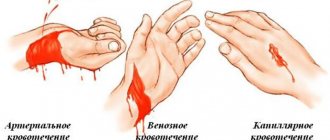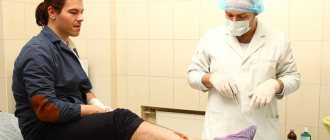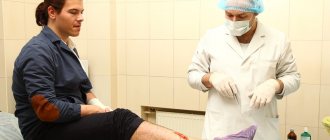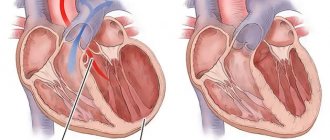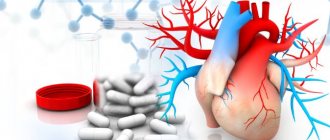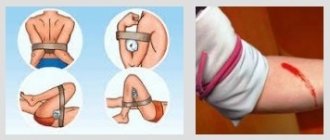Signs of bleeding
Each type of pathology has a number of its own symptoms that characterize it. However, there are common signs of blood loss. Among them:
- weakness, increased drowsiness;
- feeling of thirst;
- dizziness;
- pallor of the skin, mucous membranes;
- presence of cold sweat;
- increased heart rate, feeling of lack of air;
- decreased blood pressure;
- weak but rapid pulse;
- dyspnea;
- disturbance of consciousness, and sometimes loss.
To correctly interpret the nature of the bleeding, you should take a close look at it. After all, it is precisely by such manifestations that the type of damaged vessel is determined.
- Capillary bleeding is characterized by large drops oozing from the wound over the entire surface. Losses are usually small. The blood is red.
- Venous bleeding expires much faster. Especially if a large vessel is injured. Blood flows down in streaks. Moreover, its color is dark red, and sometimes even burgundy. Intermittent bleeding may occur. However, pulsation is not characteristic of such a pathology.
- Arterial bleeding. Outflow from the wound occurs in pulsating impulses. Sometimes it resembles a fountain. The rhythm and frequency completely repeat the pulse and heartbeats. The blood is bright scarlet. At the same time, losses are quite fast and significant. These are the main signs of arterial bleeding. They allow you to visually determine the nature of the damage.
Ways to stop bleeding
The method of stopping severe bleeding can be temporary or permanent. The first includes pre-medical manipulations. The final stop is made after hospitalization.
If the wound is small, then sometimes primary care is enough, the main methods are:
- Finger pinch.
- Application of a tourniquet.
- Tamponade.
- Use of improvised means.
Finger compression is most effective for minor bleeding. You cannot do without it in those places where it is not possible to apply a bandage:
- In the temporal part.
- On the face or neck.
- In the armpit area.
- In the area of the popliteal area, groin.
In case of extensive bleeding, a tourniquet must be applied. If you don’t have a special one, then you can take a belt or scarf.
It is important that the strip is wide, as thin ropes can cause necrosis. The tourniquet is placed on top of the fabric or clothing above the damage by 3-5 cm.
You can check the correctness of the action by checking the pulsation of the artery below the bandage; the pulsation should be weak or completely absent. The first turn is made tight, the subsequent ones a little weaker.
- Providing first aid for venous bleeding: point by point
In order not to severely compress the artery, it is necessary to remove the tourniquet for 10 minutes or loosen it after a certain period of time. In summer, the bandage can last 1-2 hours, in winter - 30-50 minutes.
It is recommended to record the time of application of the tourniquet on a piece of paper. The method is suitable for wounds of the hip and shoulder.
Tamponade is performed if emergency treatment with a tourniquet does not help. To do this, use a bandage or gauze, from which a tampon is formed to stop the bleeding. Fix it with a bandage . If it is not possible to use sterile materials, then it is necessary to disinfect a homemade tampon before clamping the artery.
Improvised means are used only as a last resort. To do this, take any clean clothing and tear it into strips suitable in width for the tourniquet. Alcohol, vodka, and tincture are used as a disinfectant.
Sources
- Zideman DA., Singletary EM., Borra V., Cassan P., Cimpoesu CD., De Buck E., Djärv T., Handley AJ., Klaassen B., Meyran D., Oliver E., Poole K. European Resuscitation Council Guidelines 2021: First aid. // Resuscitation - 2021 - Vol161 - NNULL - p.270-290; PMID:33773828
- Gyedu A., Stewart B., Otupiri E., Donkor P., Mock C. First Aid Practices for Injured Children in Rural Ghana: A Cluster-Random Population-Based Survey. // Prehosp Disaster Med - 2021 - Vol36 - N1 - p.79-85; PMID:33491619
- Singletary EM., Zideman DA., Bendall JC., Berry DA., Borra V., Carlson JN., Cassan P., Chang WT., Charlton NP., Djärv T., Douma MJ., Epstein JL., Hood NA ., Markenson DS., Meyran D., Orkin A., Sakamoto T., Swain JM., Woodin JA., De Buck E., De Brier N., O D., Picard C., Goolsby C., Oliver E ., Klaassen B., Poole K., Aves T., Lin S., Handley AJ., Jensen J., Allan KS., Lee CC., De Buck E., De Brier N., O D., Picard C ., Goolsby C., Oliver E., Klaassen B., Poole K., Aves T., Lin S., Handley AJ., Jensen J., Allan KS., Lee CC. 2021 International Consensus on First Aid Science With Treatment Recommendations. // Resuscitation - 2021 - Vol156 - NNULL - p.A240-A282; PMID:33098920
- Singletary EM., Zideman DA., Bendall JC., Berry DC., Borra V., Carlson JN., Cassan P., Chang WT., Charlton NP., Djärv T., Douma MJ., Epstein JL., Hood NA ., Markenson DS., Meyran D., Orkin AM., Sakamoto T., Swain JM., Woodin JA., De Buck E., De Brier N., O D., Picard C., Goolsby C., Oliver E ., Klaassen B., Poole K., Aves T., Lin S., Handley AJ., Jensen J., Allan KS., Lee CC., Schmölzer GM., Morley PT., Nieuwlaat R., Lang E. 2021 International Consensus on First Aid Science With Treatment Recommendations. // Circulation - 2020 - Vol142 - N16_suppl_1 - p.S284-S334; PMID:33084394
- Chang KC., Huang YK., Chen YW., Chen MH., Tu AT., Chen YC. Venom Ophthalmia and Ocular Complications Caused by Snake Venom. // Toxins (Basel) - 2021 - Vol12 - N9 - p.; PMID:32911777
- Coughlin DJ., Boulter JH., Miller CA., Curry BP., Glaser J., Fernandez N., Bell RS., Schuette AJ. An Endovascular Surgery Experience in Far-Forward Military Healthcare-A Case Series. // Mil Med - 2021 - Vol185 - N11-12 - p.2183-2188; PMID:32812042
- Sumardino S., Widodo., Poddar. Analysis of pre hospital emergency management in case of head injury. // Enferm Clin - 2020 - Vol30 Suppl 5 - NNULL - p.228-233; PMID:32713577
- Goolsby C., Rojas LE., Rodzik RH., Gausche-Hill M., Neal MD., Levy MJ. High-School Students Can Stop the Bleed: A Randomized, Controlled Educational Trial. // Acad Pediatr - 2021 - Vol21 - N2 - p.321-328; PMID:32473216
- Menger R., Lin J., Cerpa M., Lenke LG. Epidural hematoma due to Gardner-Wells Tongs placement during pediatric spinal deformity surgery. // Spine Deform - 2021 - Vol8 - N5 - p.1139-1142; PMID:32314179
- Zhao YF., Zhao JY., Hu WZ., Ma K., Chao Y., Sun PJ., Fu XB., Zhang H. Synthetic poly(vinyl alcohol)-chitosan as a new type of highly efficient hemostatic sponge with blood -triggered swelling and high biocompatibility. // J Mater Chem B - 2021 - Vol7 - N11 - p.1855-1866; PMID:32255048
What is arterial bleeding, how to determine it?
Arterial bleeding is a disorder in which arterial blood leaks out. This phenomenon is associated with various types of traumatic factors.
Arteries are vessels that carry blood from the heart to the internal organs. Their walls are thick and strong, the blood flowing through them is saturated with oxygen and moves under high pressure. The color of arterial blood is bright scarlet, so in most cases bleeding can be determined by this sign alone. In addition, there are a number of symptoms - specific signs of arterial bleeding.
Characteristic signs of arterial bleeding
Scarlet arterial blood pours out of the wound under high pressure. Doctors who arrive to help often record the following clinical picture: the patient quickly loses blood, which is released from the wound under pressure in a pulsating stream in time with the heart contractions. Measures to stop bleeding must be taken immediately.
- Providing first aid for venous bleeding
In case of severe blood loss, the patient's condition deteriorates sharply. Doctors note the following symptoms:
- paleness of the skin;
- confusion;
- fainting;
- The pulse is practically not palpable.
Indirect signs of arterial bleeding
External arterial bleeding is easy to diagnose, unlike internal bleeding.
With this type of disorder, doctors pay attention to indirect signs of arterial bleeding, which include:
- weakness;
- disturbance of consciousness;
- severe nausea;
- uncontrollable vomiting;
- dizziness;
- pallor of the skin.
To accurately determine the location of bleeding and provide medical care, it is necessary to determine the location of the damaged arterial vessel. The nature and algorithm for providing first emergency aid will directly depend on this. This plays an important role in stopping bleeding.
Venous and arterial bleeding - differences
Venous and arterial bleeding have many similarities. Their main difference is the type of damaged vessel. As noted, arteries deliver blood to the body’s organs from the heart, veins deliver blood in the opposite direction: from tissues and organs to the heart. Venous blood flows through them. It has a dark red color due to the presence of high concentrations of carbon dioxide in it. With arterial bleeding, the blood is scarlet in color.
Other differences between venous and arterial bleeding include:
- Pressure in the vessel:
the pressure in the artery is higher, so when it is injured, blood flows out in a stream, a “fountain”. - Rate of blood loss:
When an artery is damaged, blood flows out faster and is more difficult to stop. - Volume of blood loss:
with venous bleeding and timely provision of medical care, the patient rarely loses more than 500 ml of blood, with arterial bleeding - about 1 liter or more.
Extensive wounds
In this case, the rules for stopping arterial bleeding are somewhat different. The best method, available in any conditions, is to clamp the vessel slightly above the wound (a place located along the bloodstream closer to the heart). However, it is necessary to know exactly in which area the damaged artery is closest to the surface. This is where the vessel should be pressed against the bone.
Such an area can be identified by its characteristic pulsation. Once the point is found, it should be pressed down firmly. For such purposes, one finger is not enough. Clamping occurs with the entire palm or even a fist. If everything is done correctly, arterial bleeding stops immediately.
- Providing first aid for bleeding
However, it is very difficult to clamp the artery for even 15 minutes. And when transporting the victim, this may become impossible. Therefore, the above method is temporary. It makes it possible to treat the wound and prepare the necessary material to stop bleeding in other ways.
Penetrating chest injury
- close the hole tightly
- apply cold
- not allowed to speak
- breathe deeply
Signs and symptoms of penetrating chest injury
- white or bloody foam at the mouth
- the same one at the wound site
Glue the bag, a piece of plastic with tape or adhesive tape, check: if there is an entrance hole, then there may be an exit hole (in the case of a gunshot wound, it can be 10 times larger than the entrance hole), if it is small, you can seal it.
